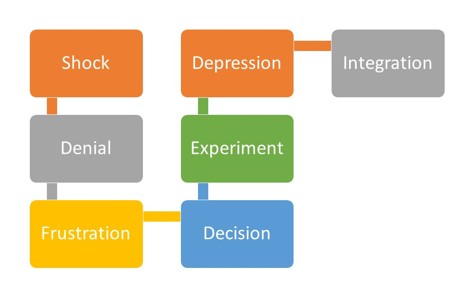As businesses evolve, one of the inherent challenges that organizations will face is that of continuous improvement and change. With new industry standards continuously being developed, change is the only constant.

Managers of any business in the service or manufacturing industry will be faced with this critical and central business function of change. The change management process may not be the smoothest, due to internal resistance. Resistance to change is to be expected, because it is human nature for individuals to become used to a comfortable norm. Slow, phased introduction is the recommendation for any critical process change, unless the change will be critical to business survival and profitability.
To help managers through the expected acceptance process during change management, a model of stakeholder behavior has been developed. This model is dubbed the Sarah Model of Change. The model simply states that change must me well managed, or else the anticipated outcome will be countered. Organizations are expecting positive changes from their employees and stakeholders, but the perception from these persons can be negative if the approach is not executed in a way that makes them feel as if the changes are genuine.
In a world where many fear many factors, inclusive of the potential of automation to replace job functions, change management will be very critical. The human ego is more destructive than managers like to think, so approach all moves with caution.
The Sarah Model of Change, highlights the mood changes experienced by those affected by organizational change. These changes are: Shock, Denial, Frustration, Depression, Experiment, Decision, Integration. While shown in the image in a sequential form, it is typical for some feelings to be skipped, or multiple emotions being experienced simultaneously during a change. What determine the experience is the severity of the change introduced.
When new concepts are introduced, recipients are generally classified as being in shock or resistant to the condition being added. Human beings are creatures of habit, and change is not always readily accepted. The solution to dealing with shock is feeding the change recipients with logical reasons for the proposed change.
Depending on the change, denial is a natural reaction. When organizational change causes massive change, such as the transfer of an individual or even a lay off initial denial may be experienced by the individual. A good example now is the advent of self-driving cars and trucks. Many persons are still not of the impression that such a change will occur, but eventually it will. As the technology advances there will come a time where persons will be substituted, and simply shifted to alternative operations.
Frustration often occurs if there is a change that requires individuals to adapt. A good example is often seen with elderly persons and technology for instance, or the transition from a manual process such as old-fashioned engineering drawings to software such as AUTOCAD. Steep learning curves will often induce frustration.
Depression can result if there are adverse effects to the recipient. Layoffs or downsizing due to industry changes or economic changes can often affect an individual adversely. Many persons expect to stay in their positions, repeating activities for years according to the traditional forty-year model, but with technological advances, this will no longer be a possibility for many. Holding on the past, versus focusing on to the future is what creates depression. Managers need to allow their employees to see the possibilities that lie ahead.
Experiment, Decision and Integration are the final coping stages. These are the latter stages of acceptance. Eventually persons will accept the changes, and adapt to the new condition. Once resistance is overcome, organizational progress can ultimately be made.
Change Management is a concept that many managers in a technologically advancing world will have to face. With the advent of phenomena such as automation, decentralization of services such as banking and technologies such as 3-D printing, it will be critical for organizations to adapt to external changes. Stakeholders and employees will have to be aware of, and prepared for this change.
